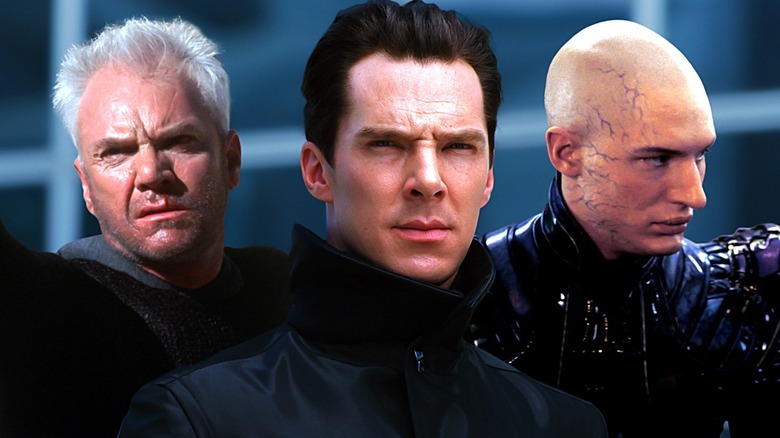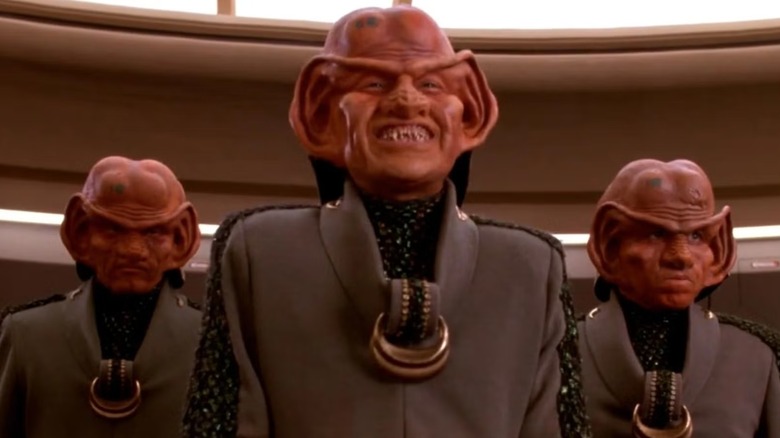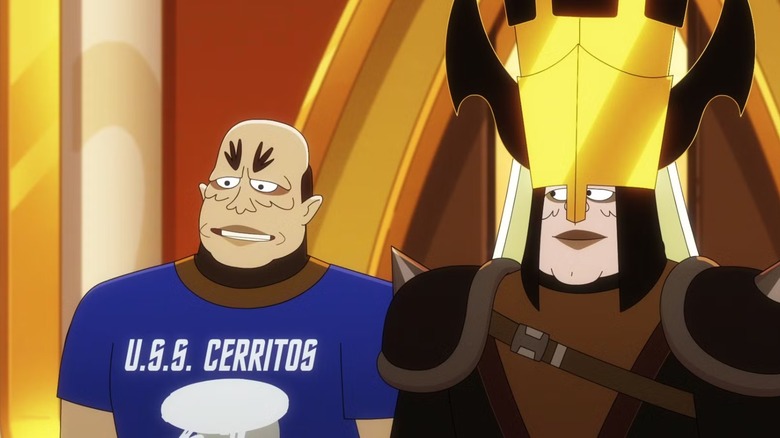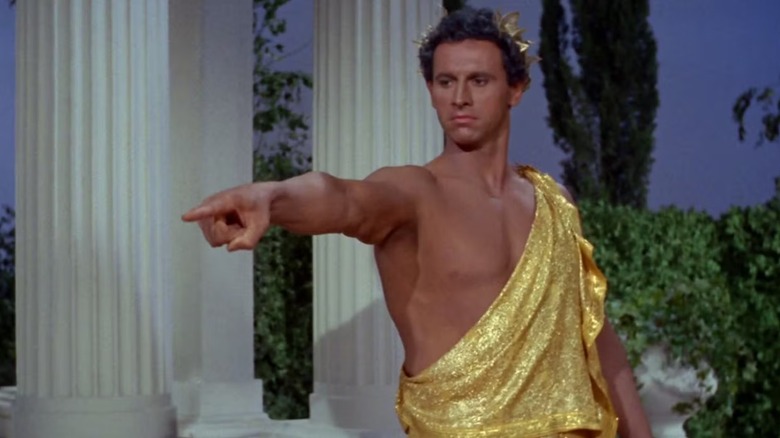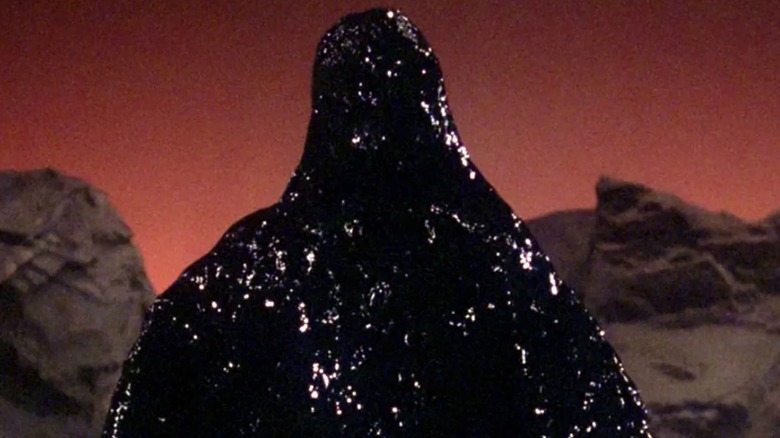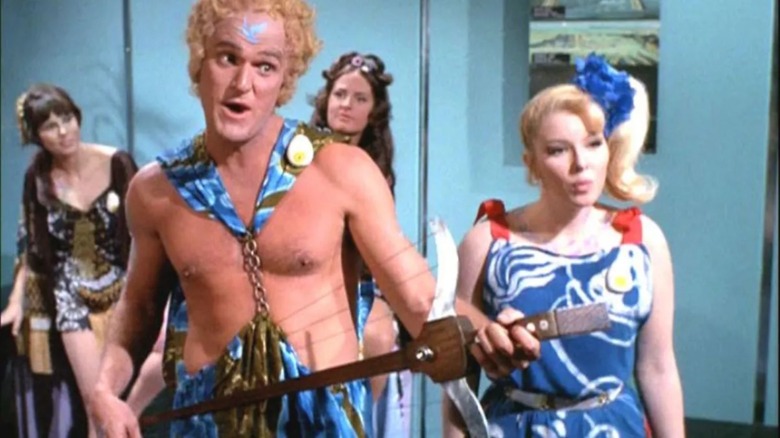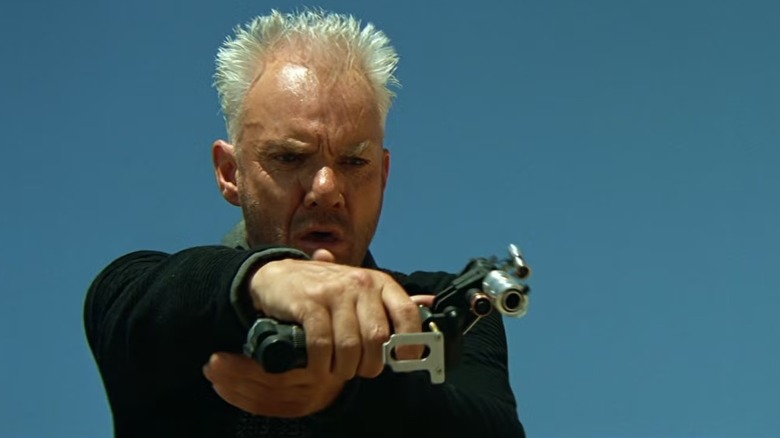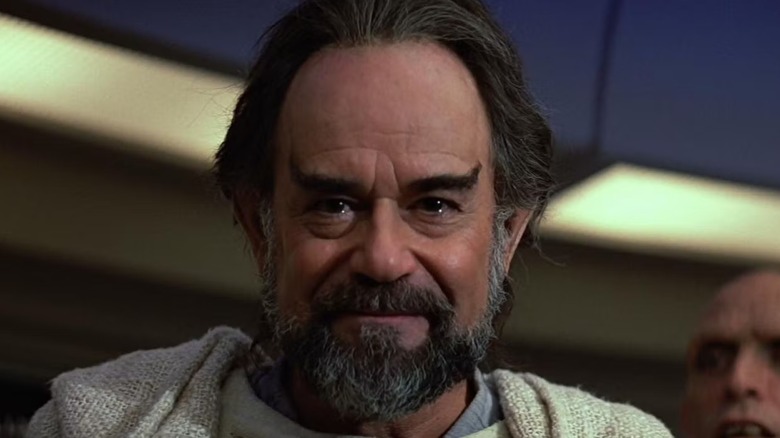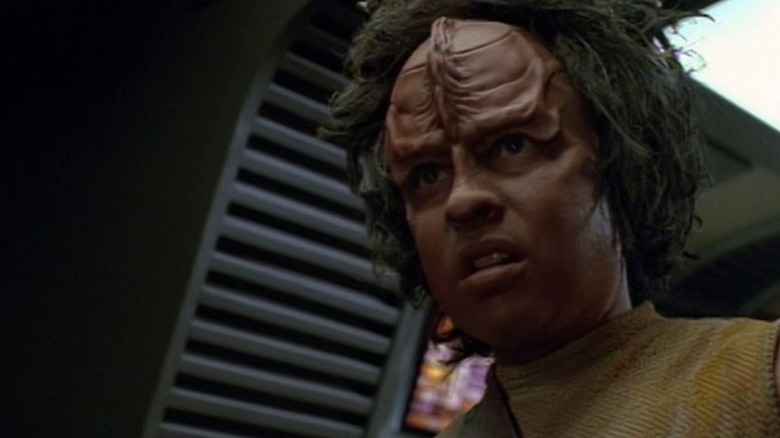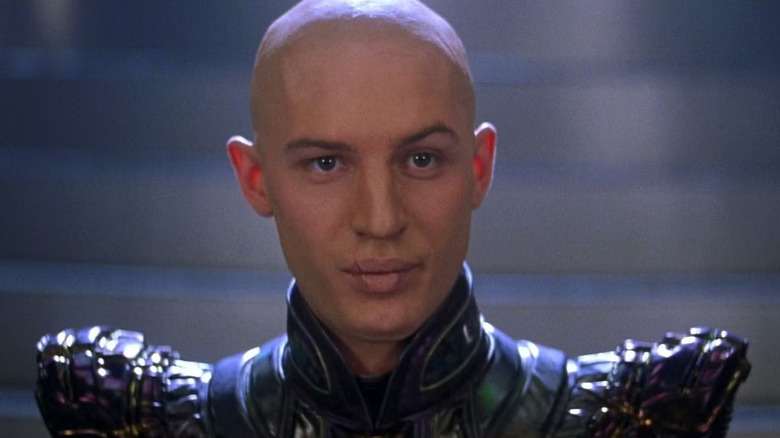The 12 Worst Star Trek Villains Ever, Ranked
"Star Trek" has a villain problem. Since the original series went to air in the fall of 1966, the galaxy-spanning franchise is at its best when sticking to its thoughtful exploration of humanity through an alien lens. What we remember is a series about hope, even when "Deep Space Nine" is brave enough to ask hard questions about colonialism and the lies of utopia. Yet a show with no conflict is a show that isn't going to stay on the air, and occasionally the bridge crew of the Enterprise finds themselves up against someone or something else that isn't going to budge from a militant point of view.
Many of these conflicts give rise to terrific enemies that leave their mark on the franchise, like the cybernetic hivemind of the Borg, or Khan Noonien Singh, who put eugenics and genetic tampering in the spotlight for stories throughout the franchise. But some enemies just can't leave a good impression on us or our Starfleet friends, flailing their way into becoming something else, or something we're better off forgetting. These are the twelve worst villainous encounters, compiled from across countless "Star Trek" stardates, roadbumps on that journey towards strange new worlds.
12. The Ferengi
The Ferengi were introduced in the fourth episode of "The Next Generation," built from scratch in order to satisfy Gene Roddenberry's mandate to avoid retreading "TOS" territory with Romulan and Klingon hostilities. Certain behaviors were quickly set in stone. Ferengi were capitalistic nightmares, played up in their first outing as almost feral, obsessive freaks to the point that their sinister mischiefs came off like camp comedy. In one of those "Star Trek" joys, however, one of these first horrid dudes would be played by Armin Shimerman, who would help give the world of the Ferengi a better overview much later, as the fan-celebrated Quark on "Deep Space Nine."
Although "The Next Generation" would give the Ferengi a few more shots at the villain prize, it quickly became clear they would never feel like a galactic level threat. Further appearances turned them into bit players in tame sex comedies, like abducting Lwaxana Troi (Majel Barrett Roddenberry) out of lust. Really, there was no choice but to gradually turn them into funky lil guys the Enterprise had to deal with sometimes, at which point fans started to honestly like the big eared hornballs. Now they've even got representatives in Starfleet, with Nog (Aron Eisenberg) earning himself an officer's rank. Now that's a glow-up.
11. The Duras Sisters, Lursa & B'Etor
Speaking of tame sex comedies, one can't discuss the political machinations of the Klingon Empire without acknowledging the Duras sisters and their... assets. Lursa (Barbara March) and B'Etor (Gwynyth Walsh) had big ambitions and even bigger windows in their practical Klingon armor for their (quite well formed) breasts to peek through. Hungry for violence — and the occasional roll in the hay, because, as our own Witney Siebold points out, liking sex is a fine thing that should be celebrated in media — the Duras sisters introduced themselves as architects of a Klingon civil war. Not a bad start! Even if one of them tried to romance up Picard (Sir Patrick Stewart) in order to sway him as their arbiter of succession. Rookie move, you go after Riker (Jonathan Frakes). You might not get what you want, but you will get an eager, consensual partner for the night.
Anyway, from such beginnings come desperation, sell-outs to Cardassians and Romulans for more money for their latest militant scheme against Gowron and the rightful empire, and constant seduction plays. They try it on Worf. They even try to land Malcolm McDowell in "Star Trek Generation," (and an unused script detail suggests she could've succeeded in banging Data (Brent Spiner), but hey, the sisters get points for lasting this long. Increasingly ineffective and ever-buxom, the Duras sisters went from nightmare to nobody, but they were a great ride. Are we still doing phrasing?
10. The Pakleds
Every time the rotund, doofy Pakleds gets mentioned, someone gets that piercing zap to the brain as they realize that race's name really is just Pack-Led; barely sentient beings led around by something slightly smarter. Introduced in one of those cornball episodes "Star Trek" is beloved for, "Samaritan Snare," the Pakleds are juuuuuust smart enough to lure the well-meaning Geordi La Forge (LeVar Burton) on board their clunky vessel to Make It Go again. Then they try to keep him via force, which almost works because in their stubborn toughness, they've scavenged a lot of decent gear. But they're still too silly and stupid to pull off keeping a guy from Starfleet, and, short of a couple one-off mentions, they don't come up in any major way ever again.
At least, not until "Lower Decks" turns the Pakleds into the lethal joke they were capable of, revealing them to be living up to their name as a Klingon extremist group was manipulating them into deadly anti-Federation attacks. The Pakleds remained terrible adversaries with their sloppy Clumpships that looked as silly as they were dangerous, right up until they bombed their own planet in an attempt to frame Captain Carol Freeman and get relocated to a resource rich planet in exchange for a "Federation" attack. Gotta love these idiots. Bad villains, but they made for fantastic TV.
9. The Greek God Apollo
"Who Mourns for Adonais" is one of those "Star Trek: The Original Series" episodes fans point to when they want to illustrate the inventive ways the production team used whatever they had available to make new alien societies. Somewhere in LA, a town production of Medea had gone off and now Paramount had a boodle of white tunics and no sword and sandal epics currently filming. Thus, the Enterprise would be bedeviled by the Greek God Apollo. In space.
There's no major trickery here. Apollo (Michael Forest) takes what today's SF nerds would consider the "Prometheus" gambit, inspired by Sir Ridley' Scott's "Prometheus," an underrated but crucial riff on creation mythology: he really IS our mythological Apollo, an ancestral teacher and godly lord. Pollux IV is the original Olympus, and he and his godly family bipped over to Earth for a while to hang with our young race. The episode itself is melancholic, even pretty in places, as this indignant and powerful "god" is desperate to rebuild a pantheon for himself, lest he fade away forever.
As a "villain," however, Apollo sucks. He's emo, he's needy, he embiggens himself into the ultimate Alpha Male to intimidate the Enterprise, and frankly, he could be a jerk in mythology, too. Not only could he bring plagues down on those he didn't like, but he was an abusive date, especially where Dionysus was involved. Apollo is tragedy incarnate, unable to force a woman's love by the end of his sole visit to "Star Trek," and thus, like the rest of his kind, he's gone like a fart drifting across the Aegean Sea.
8. Armus, the skin of evil
The death of Tasha Yar (Denise Crosby) so early into "Star Trek: The Next Generation" was a tragedy on screen and off. As an unhappy Crosby embraced her death, the act itself took audiences by surprise. Not since Spock had a main character died so abruptly on screen, and it's a top tier moment balanced by the unavoidable fact that this horror was caused by a wet Hefty bag that sounded like General Grevious filtered through a keytaur.
The episode works despite the sloppy mess that is Armus (literally, according to the "Star Trek: The Next Generation Makeup FX Journal." The team drove themselves up a wall trying to keep the costume together), but still, there's only so much you can do with a guy whose sole purpose is to be angry about everything forever. Give him a Twitter account, I guess. Left behind by a long-vanished race of people that decided cancerous negativity wasn't a trait they needed — there but for the grace of god go humanity — Armus shows up only one more time in "Star Trek" canon. He's the perfect target for crank calls from the lower decks of the USS Cerritos.
7. The Hippies of Eden
Speaking of fire sales on togas and laurels, where in the world did the original "Star Trek" costume team find fabric meant for Grandma's couch? Even for historians and retro kids who dig the vibe of the free love era, the space hippies of "The Way to Eden" are a lot to take in, visually and mentally. They're a bunch of naturalist dweebs on their way to some mythic utopia, certain that music and free love will help their cause. The music will, anyway: the space hippies pull off a heist by using a knockout frequency during their concert, and no, it wasn't "Freebird."
Well-meaning but fanatic, as villains the best wound these strawman ideas of '60s counterculture leave on the crew is continually calling Kirk (William Shatner) by the name Herbert. For their sins, they make it to what they hope is their storied Eden, where a hippie named Adam (Charles Napier) drops dead from a poison apple. Yeah, they didn't really do subtlety on the original "Star Trek."
The worst cut of all is that these hippies aren't even good hippies. They're hippies as understood by Hollywood writers; foolish, bad singers, sometimes hypocritical, and taken down the wrong path by flawed idealism. Luckily for everyone at the time, Charles Manson wouldn't put the Tate murders into action until several months after this episode aired.
6. Dr. Tolian Soran
Malcom McDowell is a brilliant actor that's brought a particular kind of menacing fire to many of his roles, from Alex in "A Clockwork Orange" to the incestuous werecat Paul in the 1982 version of "Cat People." So it's kind of amazing to give him what should be a meaty, top shelf role in the juggernaut "Star Trek" franchise and wind up with something so boring that all anyone really remembers is Patrick Stewart and William Shatner tooling around a forest on horseback. And maybe that bit where McDowell's Soran is rocking around on a shifty scaffold while one hell of a cosmic thunderstorm rolls in. It's a good shot.
And yet, Soran is the man to kill Captain James T. Kirk, after decades of Klingons, Romulans, and women of interesting repute all tried their best. It's a byproduct of Soran's true desire, which is to return to the Nexus, a place where time is frozen into a Utopic fantasyland. Shame the space hippies never made it here, but Soran, who happens to be an El-Aurian like the fan favorite Guinan (Whoopi Goldberg), is so desperate to get back to it after being wrenched out that he stops being a listener and gets a wee bit too active. Quickly forgettable, it's yet another fandom shame, however, that McDowell received death threats from guys who, as McDowell recalls with some chagrin, fortunately wasted the time of Paramount's security team.
5. Sybok
Who would've ever guessed that Spock, of all people, would have a brother that would be instantly recognizable to anyone that's ever had to get their couchlocked, skunkweed-stinking, unemployed cousin out of the basement in time to pass for sober at the Thanksigiving table? Behold Sybok (Laurence Luckbill), the villainous — this is a reach, frankly — star of "Star Trek V: The Voyage Home."
Sybok is a full blooded Vulcan who's thrown it all away to be Everclear-levels of drunk on emotion, which gags the hell out of the half-human Spock. He's also running a cult built on his larger than life personality and his ability to free the deepest emotions from people. The reason for this? To go find God at the center of the universe, only to find out the Big Fella is not really god, just some exiled jerk who will be all too happy to carjack the Enterprise and spread its "message." "Star Trek" has a real thing about malignant spirituality.
Anyway, "god" is a crappy villain too, but Sybok, meanwhile, is aiming to get a pretty good second life on "Star Trek: Strange New Worlds." Introduced in the seventh episode, "The Serene Squall," Sybok lives a hidden life in a Vulcan reeducation program where he's still pulling strings from afar. Only time will tell if young Sybok will ever face off against Captain Pike's (Anson Mount) magnificent hair.
4. The Kazon
"Star Trek: Voyager" started off rough and went through even rougher patches, but the core of it was a grand tale about being lost in space with a crew that didn't start out as tightly knit as the Enterprise-D crew was. But heaven forbid the series start off with "merely" all of that as its premise, so production had to cobble up something fresh to act as a recurring antagonist.
So they introduced inner city gangs in space. That's not a joke, that's what Rick Berman (popularly considered by the "Trek" fandom as a living cancer, and the force that kept characters like Jadzia Dax sidelined for as long as possible) and the creative team under his direction came up with. "Voyager" went to air in 1995, with the 1992 LA riots still fresh in the memories of the white locals, who are mostly unaware of the intricacies of the decades-long war between the Crips and the Bloods, and today maybe know that Kendrick Lamar sang about it.
Thus enter the Kazon, complete with matted, poofy hair and skin tones in a variety of reddish shades. A wanderer society made up of over a dozen individual gang cultures (at least someone read a book about the many regional gangs in the US), they... well, they don't really do much during their two seasons. There's an "mentor an inner city child IN SPACE" storyline, multiple attempted heists, and the "why can't we all get along" episodes, and then the Kazon pretty much vanish, only to be occasionally referenced in horror by cultural academics specializing in race relations.
3. Section 31
"Star Trek" turning its philosophical, explorative eye inwards to examine itself for flaws, like its knee-jerk but understandable reactions to genetic engineering, colonialist mistakes, etc, is a great thing. "Deep Space Nine" is a fantastic addition to the franchise that explicitly examines some of these flaws, and "Lower Decks" goes right at the throat of one-off episodes where the long-term implications of Federation meddling are never addressed. Magnificent stuff. But if "DS9" has one hindsight-driven flaw of its own, it's that it went after post 9/11 surveillance and fascistic hyperpatriotism by creating the barely supervised intel unit Section 31, and didn't eradicate the organization before going off the air.
Section 31 would then be brought up for various morally gray reasons during "Enterprise" and "Discovery;" in particular, giving them dubious reasons to be meddling in the early affairs of the Federation and its nascent treaties. Then Paramount gave the organization a movie of its own that is, generally, regarded as the worst thing "Star Trek" has ever created. It's not hard to guess why, even if you refuse to watch the thing. Nothing about Section 31 was ever meant to be lionized, no matter how cool or badass they make it look, nor even if you get Michelle Yeoh to be involved.
2. Shinzon
"Star Trek: Nemesis" was the then-25 year old Tom Hardy's third major gig, putting him head to head with Sir Patrick Stewart on a set where most of the crew knew each other. Plus, as a young actor, Hardy was struggling with a solitary nature that didn't let him gel with Stewart and a drug habit that would hit a dangerous climax in 2003, after "Nemesis" was savaged. The problems with Shinzon don't lie with his performance, however, and that's something many, including director Jonathan Frakes, who's happy to aggressively autopsy the rest of the film, agree on. It's that the whole script is a stinker, and Shinzon isn't given any clear goals beyond a bloody retread of "Blade Runner" and the Replicant desire for more life.
Yes, Shinzon is a replicant in his own right. Because nobody wants to spend the time thinking about a conflict for Jean-Luc Picard that doesn't involve the blatant mirroring of himself, poor Shinzon is a Romulan-designed clone that was supposed to be put on a grand, galaxy-altering spy quest and ended up in slavery until he made things better for himself, mostly by force. All that anyone remembers of this is that his antics got Data killed, a state of affairs that merely annoyed everyone until the final arc of "Picard" brought him back properly.
1. Khan Noonien Singh
No, not the great one played by Ricardo Montalban, and you know that. When "Star Trek: Into Darkness" began its promotional tour, the fandom took one look at star Benedict Cumberbatch's behavior in the trailer and concluded, correctly, that he was going to play an alternate version of Khan Noonien Singh. The pushback from the studio was immediate: noooooo, this is totally an all new guy named John Harrison, and he's with Section 31! Told you keeping that organization around was a mistake.
Anyway, Section 31 defrosted Khan 300 years after the Eugenics Wars and gave him a fake name, and for some reason never stated in canon that they clearly gave this guy a face job. Cumberbatch's Khan quickly devolves after his big unveiling into some sort of ranting, hyperviolent fanatic who kills Kirk (Chris Pine) for about 1.5 seconds before any drop of actual tragedy could so much as think about hitting the floor. Khan doesn't even die or get exiled after all of this. They put him back in the freezer. Absolutely worthless outing for what had originally been one of the best antagonists "Star Trek" ever created.
